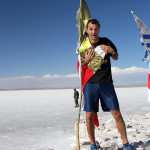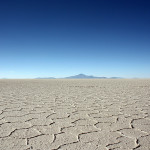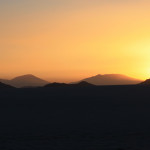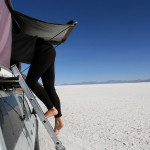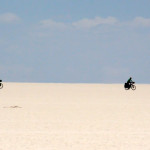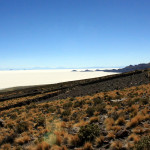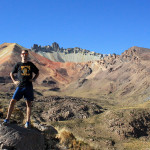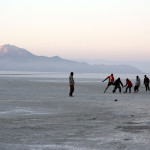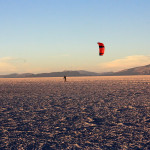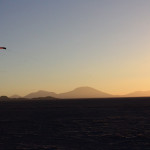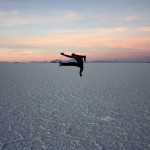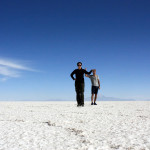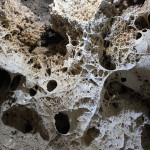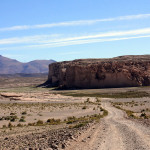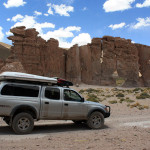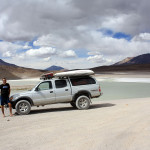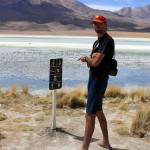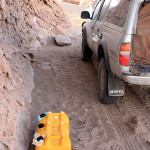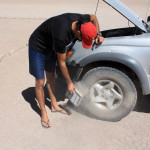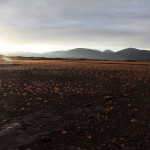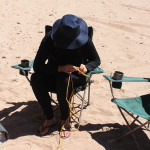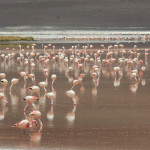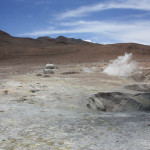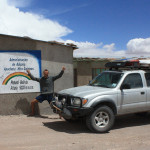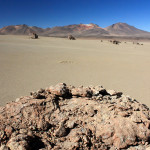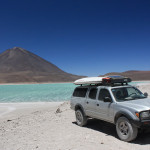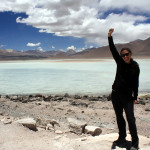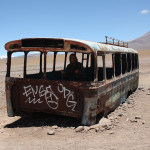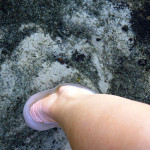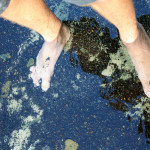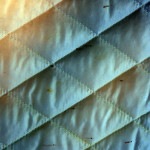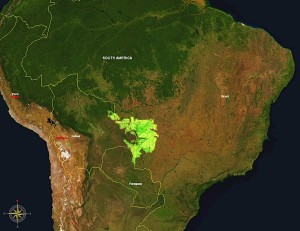With so much build-up and planning, could Bolivia’s Salar de Uyuni (salt flats) and the wild area south of the flats (Sur Lipez Province) deliver? F$#K YEAH it did.
Because of limited fuel options, many independent travelers visit the salt flats for a few nights and then make a pit stop back in Uyuni (town on the east side of the flats) to fill up before heading south to the Sur Lipez province (the southwest circuit). George wasn’t having it – no pit stops. Instead we added 3 jerry cans for a total of 6 jerrys.
The extra gasoline and practical tips from a helpful Swiss gentlemen (Marco) at the tourist office in Sucre, Bolivia inflated our confidence. With 48 gallons of gasoline, 30 gallons of water plus 20 days worth of food and extra rice, garlic and cocoa leaves to trade with locals in case of trouble, we were ready to tackle what was to come. And no, in our day-to-day lives we are not preppers.
Day 1: Uyuni’s train cemetery to Isla Pescado
In our typical fashion, we were running late and didn’t head out on to the salt flats until the afternoon after a obligatory visit to Uyuni’s train cemetery.
- The 2014 Dakar would be routed through Bolivia for the first time.
First stop was a salt extraction operation where George quickly broke the first of Marco’s rules, “stay away from areas where there is water on the salt”. We drove right through the slushy middle of the operation to snag some photos.
Driving on the Salar is like being on another planet, drive fast or slow, turn left or right, it doesn’t matter. We had some of our best fuel mileage on the ultra flat Salar.
- No Bulgarian flag…no problem, George makes his own.
- This could be dancing.
Getting to our selected camp spot, Isla Pescado, we broke the second of Marco’s rules, “the flats are the thinnest around the islands and at the entrances/exits – do not drive there”. We promtly drove right onto the island to set camp for the night, and would be all alone for our first night.
Day 2 – 3: Coqueza to Isla Incahuasi
The next morning, we visited nearby Coqueza. Each step up to the the mirador to get a better look at Volcan Tunupa was a struggle because of the altitude. After the hike, we made it to Isla Incahuasi, another obligatory stop because of the dense cacti growing on the island. This island is overrun with tourist groups during the day, but it calms down in the evening and was serendipitous stop for us.
- Entrance into Coqueza
- A land bridge into Conqueza
- Quinoa growing
- Volcan Tunupa
George was able to scratch his sports itch playing football with some locals the first night.
After befriending the fellow players, we were able to purchase 5 more gallons of gasoline the next day. That evening, the wind picked up enough for G to mountain board. Finally, we were gifted with a surprise encounter when Southern Tip Trip and Patagonia or Bust rolled in.
Day 4: Salar de Uyuni to Sur Lipez
Tearing ourselves away from our friends and the warmth of our bed the next morning, we bombed away from Incahuasi in the depth of pre-dawn darkness to catch a sunrise in the middle of the flats.
It was then time for our ‘funny pictures’ and my opportunity to finally tower of George. I will clutch on to the memory for the rest of my life.
The Salar exit point that we took was a little slushy, but Vida piled on through the muck and delivered us to Gruta de last Galaxias to see a grotto filled with petrified algae. We then managed to purchase another 5 gallons of gas in San Juan from a local business woman who had the dried goods and gasoline markets corned. Although we paid her a little more than we should have, it was nice to see how excited she was to make the sale. We celebrated the gasoline purchase with a cold beer, a real luxury at that point.
Heading further into Sur Lipez province, we camped out near a condor reserve in our ground tent and worked on perfecting our tent cooking technique.
Day 5: To Copa del Mundo
In the morning, we unsuccessfully tried to spot a condor. George went exploring, and believing he heard a nest of baby condors, misguidedly left his flip flops behind to approach unnoticed. The nest was no nest, but some other lone baby bird crying. He promptly very uncomfortably hot footed it back to his shoes.
That evening we found a choice camping spot behind a big rock for some wind shadow. We had unknowingly parked ourselves under ‘Copa del Mundo’ or the ‘World Cup’, a stop from many of the tour operators. We would be in their photos the following morning cooking eggs for breakfast.
Day 6:
After ruining a few tourist photos and finishing our eggs, we headed north to meet up with the road that would take us through Valle de Rocas and to the lakes district. The road started to degrade here requiring high clearance which meant creeping along at a snails pace for the next day and a half.
We camped in our ground tent that evening on an open plane under the impressive 5947 meter Volcan Caquella. It was our second night cooking in the tent. To someone who hasn’t had a roof over her head in the last year and a half, cooking inside the tent turned out to be nice and toasty.
- Volcan Caquella
- A storm moving in
Day 7:
Our first stop on day seven was Laguna Canany. You may call it the stinky lake. We followed the route of other travellers off the main road forcing us to navigate through a handful of ravines. We realized that the road we were on was no more when George jumped in the ravine we were facing and I could barely see the top of his head. We agreed that finding another way was our only choice. My vote was to turn around, but George used his driver privileges to navigate us down a steep hill to the Laguna. He was smiling ear to ear on the way down reveling in the adventure while I was containing the game-ending scenarios my mind was concocting.
Exiting the car, the air wafting towards us was ripe with the smell of sulfur. We made quick stops at Laguna Chiar Khota and Laguna Honda before deciding to do a little more exploring on a slanted auxiliary road flanked by dirt banks. Turning around proved difficult, so we were forced to use the rear diff lock for the first time.
The road to the Arbol de Piedra (a stone tree sculpted by the elements) was an absolute sand pit. We balked at some bikers we saw in the distance struggling through the thick sand. Half of me can respect anyone who has enough gumption to cycle through Bolivia while the other half of me thinks they must be off their rocker.
-
Mandatory washing
-
Volcan Caquella
-
Laguna Canany
-
Lunch at Laguna Canany
-
Arbol de Piedra
-
Gasing up
- Mandatory washing
- Volcan Caquella
- Laguna Canany
- Lunch at Laguna Canany
- Arbol de Piedra
- Gasing up
Day 8:
Day eight promised to be a good day since we would be crossing into Reserva Eduardo Avaroa (Lagunas Park). The ranger station at the park entrance sits on the west side of Laguna Colorado that was impressively jammed with what I can only guess was hundreds of thousands of flamingos.
That evening we snagged another beautiful camp spot in the belly of a canyon hoping to hide from the unrelenting wind and celebrating with another toasty fire.
-
One dirty air filter
-
Piedra de Arbol
-
Laguna Colorado
- One dirty air filter
- Piedra de Arbol
- Laguna Colorado
Day 9:
By the morning of day nine, I was reaching the breaking point on number of consecutive days without a shower. Adding in the beating sun, sand blasting wind and cold nights, George decided we needed a distraction in the form of a mountain of crepes. While he cooked, I practiced some knots.
After a brief visit to the Bolivian Aduana at 5020 meters situated next to a borax mine, we stopped by Geiser Sol de Mañana and then headed to the thermal baths situated near Salar de Chalviri to wash away some of the nine day dirt build up. Thankfully, we managed to arrive at a time when there were not tour groups. The family who runs the hot springs took advantage as well of the down time. No sooner had we jumped into the pool then a four year old was passed to us to look after until her older siblings got into the pool. George and I quickly bonded with the five children.
We found a choice camping spot in the midst of Dali’s Rocks for the night. Truthfully, it took us over five attempts to make it up the steep sand hill but George persevered.
- Laguna Colorado
- Thermal bath
- Geiser Sol de Mañana
- Bolivian Aduana at 5020 meters
- Sun setting on Dali’s rocks
Day 10:
Our last day in Bolivia began in epic style with a 360-degree view along with coffee and crepes on top of Dali’s rocks. The decent down from the rock we were perched upon was equally as memorable because of a close call (we’ll leave it at that). We had the truck packed and ready to go when two park rangers drove up and let us know that we were not supposed to drive anywhere near Dali’s rocks and hadn’t we received and information packet? Well, no we didn’t. The park still has some administration kinks to work out, but from George’s observations they had already made many positive changes since his last visit in 2010.
We rounded out the southwest circuit with a visit to another set of breathtaking lakes (Laguna Verde and Laguna Blanca). Enduring a few more miles of dirt road, we finally made it to the beautiful paved highway that would deliver us down nearly 2500 meters into San Pedro de Atacama Chile.
- Dali’s rocks
- Best morning coffee of the trip
- Laguna Verde
- Laguna Blanca
- Bolivia/Chile border
- Highway to San Pedro







